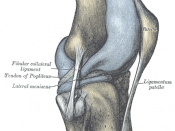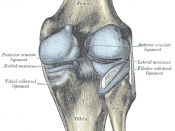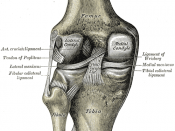The Injury
The PCL is in the center of your knee just behind the ACL. It connects the femur to the tibia and it limits the backward motion of the tibia and functions as one of the stabilizers of the knee joint. Injury to the PCL is relatively rare and certainly less common that an ACL injury. Fortunately, PCL injuries can be less debilitating to patients than ACL injuries. Most commonly, PCL injuries occur during automobile accidents or if the knee takes a blow during hyper-extension. PCL injuries are often subtle and can be easily overlooked, even by a physician. The patient may have slight soreness or stiffness and mild swelling.
A ruptured PCL will allow the tibia to assume a more posterior position relative to the femur if a posterior force is applied to the tibia. When the PCL is torn, the extensor mechanism, including the patella and the patellar tendon, forcefully hold the tibia in a reduced position, which results in increased patellofemoral pressure.
Increased patellofemoral loading is also caused by a vector change resulting from posterior tibial displacement. This can explain complaints of patellofemoral pain in patients who have PCL-deficient knees.
The PCL injury is detected by:
History: the patient history usually consists of a fall with a blow to the anterior aspect of the proximal tibia. Patients who have PCL injuries usually do not have incapacitating pain, and they report vague symptoms such as unsteadiness or insecurity of the knee. Patients who have chronic injuries may report patellofemoral symptoms.
Physical Exam: usually does not reveal findings of severe ligament injury. Most patients will have nearly full range of motion. Several tests aid in the diagnosis of PCL injuries.
MRI: shows the ligament and soft tissue damage of the knee.
Posterior drawer test: The examiner...


